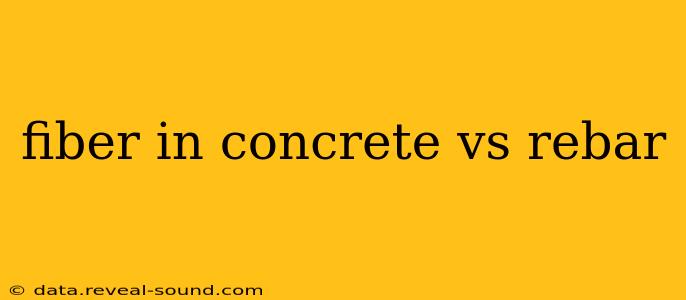Reinforcement is crucial for enhancing the structural integrity of concrete, and both steel rebar and fibers offer distinct advantages. Choosing the right reinforcement method depends heavily on the specific application and desired properties of the final concrete structure. This article will delve into the key differences between fiber-reinforced concrete (FRC) and rebar-reinforced concrete, helping you understand which option is best suited for your needs.
What is Fiber-Reinforced Concrete (FRC)?
Fiber-reinforced concrete incorporates short, discrete fibers into the concrete mix. These fibers can be made from various materials, including steel, polypropylene, glass, and carbon. The fibers significantly improve the concrete's tensile strength, toughness, and resistance to cracking, making it ideal for applications where impact resistance and durability are paramount. Unlike rebar, the fibers are dispersed throughout the concrete matrix, providing distributed reinforcement.
Advantages of Fiber-Reinforced Concrete:
- Improved Tensile Strength: FRC exhibits significantly higher tensile strength than plain concrete, reducing the likelihood of cracking.
- Enhanced Impact Resistance: The distributed nature of the fibers makes FRC highly resistant to impact damage and sudden loads.
- Increased Durability: FRC offers better resistance to freeze-thaw cycles and abrasion.
- Reduced Shrinkage Cracking: The fibers help mitigate shrinkage cracking during the curing process.
- Faster Construction: Often easier and faster to place than rebar, reducing overall project time.
- Improved Workability: In many cases, the addition of fibers can improve the workability of the concrete mix.
Disadvantages of Fiber-Reinforced Concrete:
- Limited Strength in Large Sections: FRC is generally not suitable for large structural elements requiring extremely high tensile strength, where rebar is typically necessary.
- Cost: Depending on the type of fiber used, FRC can sometimes be more expensive than plain concrete.
- Fiber Orientation: The effectiveness of FRC can be influenced by the orientation and distribution of the fibers within the mix. A consistent and well-distributed mix is crucial.
- Bond Strength: While the bond between fibers and concrete is generally good, it might not be as strong as the bond between rebar and concrete.
What is Rebar-Reinforced Concrete?
Rebar-reinforced concrete uses steel bars (rebar) embedded within the concrete to provide tensile strength. Rebar is typically placed in a specific pattern, designed to withstand the anticipated stresses and loads on the structure. This method is widely used in large-scale construction projects for its robust structural capabilities.
Advantages of Rebar-Reinforced Concrete:
- High Tensile Strength: Rebar offers exceptional tensile strength, making it suitable for large and heavily loaded structures.
- Proven Technology: Rebar reinforcement is a mature and well-understood technology with established design standards and practices.
- Adaptability: Rebar placement can be precisely controlled to suit specific structural requirements.
- Cost-Effective (for large structures): For large-scale projects, rebar reinforcement is often cost-effective.
Disadvantages of Rebar-Reinforced Concrete:
- Labor Intensive: Placing and securing rebar is labor-intensive and time-consuming.
- Corrosion: Rebar is susceptible to corrosion if not properly protected.
- Potential for Cracking: While rebar prevents complete failure, cracking can still occur between the rebar and the concrete.
- Complex Design: Designing rebar reinforcement for complex structures can be challenging.
Fiber in Concrete vs. Rebar: Which is Better?
The "better" option depends entirely on the specific application. There's no single superior method.
- For large structural elements requiring high tensile strength (e.g., bridges, high-rise buildings): Rebar reinforcement is the clear choice.
- For smaller structures, applications needing improved impact resistance, or where construction speed is prioritized (e.g., pavements, shotcrete, overlays): Fiber-reinforced concrete is often preferred.
- In some cases, a hybrid approach is used, combining both rebar and fibers for optimal performance.
What are the different types of fibers used in concrete?
Several types of fibers are used in fiber-reinforced concrete, each offering unique properties:
- Steel Fibers: Offer high tensile strength and good ductility.
- Polypropylene Fibers: Provide excellent impact resistance and reduced shrinkage cracking.
- Glass Fibers: Relatively inexpensive and offer good tensile strength.
- Carbon Fibers: Exhibit exceptionally high strength-to-weight ratios.
How do I choose the right fiber for my project?
The selection of appropriate fibers depends on factors such as the required strength, durability, cost constraints, and the specific application. Consulting with a structural engineer is crucial for determining the optimal fiber type and quantity for your project.
What are the common applications of fiber-reinforced concrete?
Common applications include pavements, industrial floors, retaining walls, shotcrete, and precast elements.
By understanding the strengths and weaknesses of both fiber-reinforced concrete and rebar-reinforced concrete, engineers and contractors can make informed decisions to select the optimal reinforcement method for their specific projects. Remember to always consult with structural engineering professionals for complex or large-scale projects.
